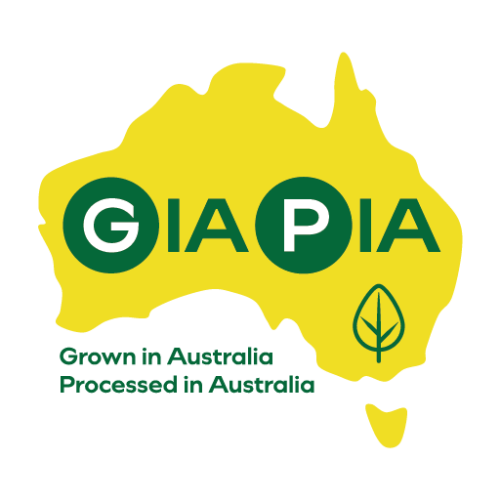GIAPIA: Grown in Australia, Processed in Australia
What is GIAPIA?
GIAPIA stands for Grown in Australia, Processed in Australia — it’s our commitment to complete authenticity and origin transparency.
Unlike vague or misleading claims such as:
-
“Made in Australia”
-
“100% Australian-owned”
-
“Made from local and imported ingredients”
…GIAPIA guarantees that what you eat is 100% grown and processed on Australian soil. No fine print. No loopholes. No imported concentrates rebranded as local.

Not All “Australian” Claims Are Equal
Food labels can be misleading — sometimes intentionally so. Many products that sound Australian are far from it once you peel back the label.
Here’s how some of the common claims get used in ways that mislead consumers:
“Made in Australia” — but mostly foreign ingredients
A fruit juice might carry a “Made in Australia” label, but:
- The juice concentrate is imported (e.g. from Brazil or China).
- They add Australian water, bottle it here, and voilà — it qualifies as “Made in Australia”.
- Why? Because final manufacturing occurred here, even though the key ingredient wasn’t grown here.
“100% Australian-owned” — but ingredients and processing aren’t local
A snack brand might be 100% Aussie-owned, but:
- Ingredients like sugar, cocoa, nuts, or palm oil are sourced from overseas.
- The product might even be partially processed overseas, then final-packaged here.
- It feels Aussie, but the food you’re eating is not grown or made here.
“Product of Australia” vs “Made in Australia”
These sound similar but mean very different things:
- “Product of Australia” means virtually everything — ingredients and processing — must be from Australia.
- “Made in Australia” only means significant transformation happened here. So:
- Imported meat can be marinated or frozen here and legally sold as “Made in Australia”.
- An imported spice blend can be put into Australian-made packaging and still qualify.
“Made from Australian and imported ingredients”
This is often used as a catch-all — and lets brands:
- Use a tiny percentage of Australian produce (say 10% honey), while the rest is imported.
- Still flash a green-and-gold label on the product.
- Confuse consumers into thinking it’s mostly local.
Made in Australia can still be owned by a foreign company
Foreign-owned manufacturers using local claims
- A food product can be “Made in Australia” and still be owned by a foreign company.
- The profit doesn’t stay here, but the marketing gives a local feel.
- Many multinationals use this to appear local while producing here for convenience or tariff benefits.

Why GIAPIA Matters
The food industry is full of smoke and mirrors — where a splash of imported juice or a dash of local flavour can somehow qualify as “Australian made”.
GIAPIA cuts through that. It’s not about where the paperwork’s done — it’s about where the food itself comes from.
When you see the GIAPIA logo, you can be confident that:
- Every ingredient is grown in Australia
- Every process, from picking to packaging, is done within Australia
- You’re supporting local growers, local jobs, and local integrity
